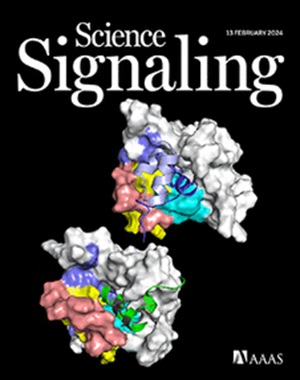adar2介导的GluA2在稳态突触可塑性中的Q/R编辑
IF 6.6
1区 生物学
Q1 BIOCHEMISTRY & MOLECULAR BIOLOGY
引用次数: 0
摘要
稳态突触可塑性是一种负反馈机制,神经元通过调节其突触强度来抵消活动的慢性增加或减少。作为对活动剥夺的反应,突触强度通过增加突触上AMPA受体(ampar)的数量而增强,特别是Ca2+可渗透的ampar。在此,我们发现在稳态升级过程中Ca2+渗透性AMPAR的增加是由编码AMPAR亚基GluA2的GRIA2 mRNA转录后编辑减少介导的。在培养的神经元中,活动剥夺导致未编辑的GluA2数量增加,使得其离子通道孔含有谷氨酰胺(Q)密码子而不是精氨酸(R),并且突触中Ca2+可渗透的ampar数量增加。这些影响是由剪接因子依赖性的ADAR2丰度和活性的降低介导的。ADAR2的过表达或crispr - cas13对GluA2转录本的定向编辑阻断了活动剥夺初级神经元的稳态升级。在小鼠中,黑暗饲养导致初级视觉皮层(V1)中glua2编码转录本的Q-to-R编辑减少,V1中ADAR2的病毒过表达阻断了稳态突触可塑性的诱导。这些发现表明,GluA2编辑的活动依赖性调节有助于稳态突触可塑性。本文章由计算机程序翻译,如有差异,请以英文原文为准。
ADAR2-mediated Q/R editing of GluA2 in homeostatic synaptic plasticity
Homeostatic synaptic plasticity is a negative feedback mechanism through which neurons modify their synaptic strength to counteract chronic increases or decreases in activity. In response to activity deprivation, synaptic strength is enhanced by increasing the number of AMPA receptors (AMPARs), particularly Ca2+-permeable AMPARs, at the synapse. Here, we found that this increase in Ca2+-permeable AMPARs during homeostatic upscaling was mediated by decreased posttranscriptional editing of GRIA2 mRNA encoding the AMPAR subunit GluA2. In cultured neurons, activity deprivation resulted in increases in the amount of unedited GluA2, such that its ion channel pore contains a glutamine (Q) codon instead of arginine (R), and in the number of Ca2+-permeable AMPARs at the synapse. These effects were mediated by a splicing factor–dependent decrease in ADAR2 abundance and activity in the nucleus. Overexpression of ADAR2 or CRISPR-Cas13–directed editing of GluA2 transcripts blocked homeostatic upscaling in activity-deprived primary neurons. In mice, dark rearing resulted in decreased Q-to-R editing of GluA2-encoding transcripts in the primary visual cortex (V1), and viral overexpression of ADAR2 in the V1 blocked the induction of homeostatic synaptic plasticity. The findings indicate that activity-dependent regulation of GluA2 editing contributes to homeostatic synaptic plasticity.
求助全文
通过发布文献求助,成功后即可免费获取论文全文。
去求助
来源期刊

Science Signaling
BIOCHEMISTRY & MOLECULAR BIOLOGY-CELL BIOLOGY
CiteScore
9.50
自引率
0.00%
发文量
148
审稿时长
3-8 weeks
期刊介绍:
"Science Signaling" is a reputable, peer-reviewed journal dedicated to the exploration of cell communication mechanisms, offering a comprehensive view of the intricate processes that govern cellular regulation. This journal, published weekly online by the American Association for the Advancement of Science (AAAS), is a go-to resource for the latest research in cell signaling and its various facets.
The journal's scope encompasses a broad range of topics, including the study of signaling networks, synthetic biology, systems biology, and the application of these findings in drug discovery. It also delves into the computational and modeling aspects of regulatory pathways, providing insights into how cells communicate and respond to their environment.
In addition to publishing full-length articles that report on groundbreaking research, "Science Signaling" also features reviews that synthesize current knowledge in the field, focus articles that highlight specific areas of interest, and editor-written highlights that draw attention to particularly significant studies. This mix of content ensures that the journal serves as a valuable resource for both researchers and professionals looking to stay abreast of the latest advancements in cell communication science.
 求助内容:
求助内容: 应助结果提醒方式:
应助结果提醒方式:


